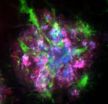(Press-News.org) A recent study based on a Chinese sample gives an answer to this question. The research shows that in Chinese culture, emotion- expressive suppression is not only able to dampen negative emotion effectively, but also dampen negative emotion faster than Cognitive reappraisal. This sheds much light on how to quickly regulate negative emotion in urgent situations, particularly when people from East-Asian cultures are concerned.
This study has been published in SCIENCE CHINA: Life Sciences (IN CHINESE) , which is titled "The efficiency of negative emotion regulation: the comparison between cognitive reappraisal and expression suppression". Using high temporal-resolution Event-Related Potentials and a rigorous experimental design, the authors provided an important perspective for the solution of a long-lasting issue of public concern: how to reduce the impact of negative emotion efficiently, especially in urgent and demanding situations where one needs to dampen socially inappropriate emotion (such as rage and impulse) very quickly. The corresponding author of this paper is Dr.Jiajin Yuan, an associate professor and a principal investigator in the Faculty of Psychology, Southwest University of P.R.China.
It may cause serious health and social problems if negative emotions can not be reduced effectively,that is why it is so important to study how to dampen negative emotion quickly and effectively. Many prior studies based on Caucasian populations indicate that emotion-expressive suppression is not only unable to dampen negative emotion, but is also at a risk of enhancing physiological consequences of emotional reaction. Cognitive reappraisal, however, can effectively reduce the negative emotion experiences and emotion-related physiological responses. However, different from European-American cultures that encourage free expression of emotion, Chinese culture is characterized by the collectivistic cultural norms, which highlight relational harmony and self-discipline. Thus, people from East-Asian nations may be culturally trained to suppress the expression of negative emotions. Based on these considerations, the authors hypothesized that expressive suppression may be similar to, or even better than, reappraisal in regulating the emotional impacts of negative stimuli in Chinese people.
Using emotional scenes for the induction of negative emotion. The results of this study confirmed the authors' hypothesis: cognitive reappraisal and expression suppression are both effective in reducing the negative emotional experiences induced by the arousing scenes, to a similar extent. Furthermore, by the analyses of electrophysiological data, it was found that expression suppression reduced negative emotional reactions at a faster speed than cognitive reappraisal. The brain potentials related to negative emotion were reduced before 1 second post stimulus during expressive suppression; while cognitive reappraisal did not decrease emotion-related brain potentials until about 1.5 seconds post stimulus. However, the faster reduction of emotion-related physiological consequences during expressive suppression is based on heavier consumption of cognitive resources, in comparison with cognitive reappraisal.
These findings give insights into the regulation of socially inappropriate emotion reactions, especially in urgent situations and when east-Asian cultural settings are involved. However, what this study observed is a short-term effect of emotion-expressive suppression, and this effect should be specific to the several seconds post stimulus." Because there is evidence that habitual suppression of negative emotion is positively correlated with depression, the long-term effect of expressive suppression needs to be further investigated", said Yuan.
INFORMATION:
This study was funded by the National Natural Science Foundation Project (grant number: 31170989, 31371042).
Source: Jiajin Yuan , Quanshan Long, Nanxiang Ding, et al. The efficiency of negative emotion regulation: the comparison between cognitive reappraisal and expression suppression. SCIENCE CHINA: Life Sciences, 2014, 44: 602 – 613.
Link to paper:http://life.scichina.com:8082/sciC/CN/abstract/abstract514763.shtml
Science China Press http://www.scichina.com/
Is expressive suppression effective in reducing negative emotion?
2014-09-29
ELSE PRESS RELEASES FROM THIS DATE:
Using the brain to forecast decisions
2014-09-29
You're waiting at a bus stop, expecting the bus to arrive any time. You watch the road. Nothing yet. A little later you start to pace. More time passes. "Maybe there is some problem", you think. Finally, you give up and raise your arm and hail a taxi. Just as you pull away, you glimpse the bus gliding up. Did you have a choice to wait a bit longer? Or was giving up too soon the inevitable and predictable result of a chain of neural events?
In research published on 09/28/2014 in the journal Nature Neuroscience, scientists show that neural recordings can be used to forecast ...
Smart, eco-friendly new battery to solve problems
2014-09-29
Present-day lithium batteries are efficient but involve a range of resource and environmental problems. Using materials from alfalfa (lucerne seed) and pine resin and a clever recycling strategy, Uppsala researchers have now come up with a highly interesting alternative. Their study will be presented soon in the scientific journal ChemSusChem.
'We think our discovery can open several doors to more environment-friendly, energy-efficient solutions for the batteries of the future,' says Daniel Brandell, Associate Professor at the Department of Chemistry, Uppsala University, ...
Protein that causes frontotemporal dementia also implicated in Alzheimer's disease
2014-09-29
SAN FRANCISCO, CA—September 28, 2014—Researchers at the Gladstone Institutes have shown that low levels of the protein progranulin in the brain can increase the formation of amyloid-beta plaques (a hallmark of Alzheimer's disease), cause neuroinflammation, and worsen memory deficits in a mouse model of this condition. Conversely, by using a gene therapy approach to elevate progranulin levels, scientists were able to prevent these abnormalities and block cell death in this model.
Progranulin deficiency is known to cause another neurodegenerative disorder, frontotemporal ...
Predicting landslides with light
2014-09-29
WASHINGTON, Sept. 29, 2014—Optical fiber sensors are used around the world to monitor the condition of difficult-to-access segments of infrastructure—such as the underbellies of bridges, the exterior walls of tunnels, the feet of dams, long pipelines and railways in remote rural areas.
Now, a team of researchers in Italy are expanding the reach of optical fiber sensors "to the hills" by embedding them in shallow trenches within slopes to detect and monitor both large landslides and slow slope movements. The team will present their research at The Optical Society's (OSA) ...
Scientists identify the signature of aging in the brain
2014-09-29
How the brain ages is still largely an open question – in part because this organ is mostly insulated from direct contact with other systems in the body, including the blood and immune systems. In research that was recently published in Science, Weizmann Institute researchers Prof. Michal Schwartz of the Neurobiology Department and Dr. Ido Amit of Immunology Department found evidence of a unique "signature" that may be the "missing link" between cognitive decline and aging. The scientists believe that this discovery may lead, in the future, to treatments that can slow or ...
Nivolumab shows signs of superior response rate compared to standard chemo in advanced melanoma
2014-09-29
The monoclonal antibody nivolumab achieves superior response rates and a longer duration of response than standard chemotherapy[1] in patients whose melanoma has progressed after treatment with ipilimumab, according to phase III data presented at the ESMO 2014 Congress in Madrid, Spain.
"Previously-treated advanced melanoma patients have limited options," says the study's principal investigator, Professor Jeffrey Weber, Director of the Donald A. Adam Comprehensive Melanoma Research Center of Excellence at the Moffitt Cancer Centre, Tampa, Florida.
Nivolumab is an antibody ...
New data on combination treatments for melanoma
2014-09-29
Combination therapy with both BRAF inhibitor vemurafenib and MEK inhibitor cobimetinib achieves greater progression-free survival and response rates than vemurafenib plus placebo in BRAF-mutation positive melanoma, according to phase III data presented at the ESMO 2014 Congress in Madrid, Spain.
"Before the results of this study, we knew that cobimetinib plus vemurafenib could be safely delivered together with highly promising rates of tumour shrinkage; however until the performance of a scientifically rigorous randomised trial the potential magnitude of this benefit ...
Studies report new findings on treatment options for mesothelioma
2014-09-29
Treating patients with high-dose radiotherapy after chemotherapy and surgery for malignant pleural mesothelioma does not achieve improvements in local relapse and overall survival, according to data from a prospective randomized phase II trial presented at ESMO 2014 Congress in Madrid.
"Mesothelioma remains a difficult disease to find better treatment options for, so we asked whether high-dose hemithoracic radiotherapy would decrease the rate or delay the time of local recurrence after chemotherapy and radical surgery," says lead author Prof Rolf A. Stahel, from the ...
Promising results shown with targeted approaches in subsets of non-small cell lung cancer
2014-09-29
The BRAF inhibitor dabrafenib has significant anti-tumour activity in patients with advanced BRAF V600E mutant non-small cell lung cancer whose disease has progressed after chemotherapy, according to phase II data presented at the ESMO 2014 Congress in Madrid, Spain.
"Reports of lung cancers bearing mutations in BRAF have generated considerable interest because these mutations may be associated with increased sensitivity to BRAF tyrosine-kinase inhibiting agents," says lead author Dr David Planchard, pulmonary oncologist at the Gustav-Roussy Cancer Campus, Paris, France. ...
Scientists make droplets move on their own
2014-09-29
Droplets are simple spheres of fluid, not normally considered capable of doing anything on their own. But now researchers have made droplets of alcohol move through water. In the future, such moving droplets may deliver medicines, etc.
To be able to move on your own – to be self-moving – is a feature normally seen in living organisms. But also non-living entities can be self-moving, report researchers from University of Southern Denmark and Institute of Chemical Technology in Prague, Czech Republic.
The researchers have made alcohol droplets move in a life-like way, ...


